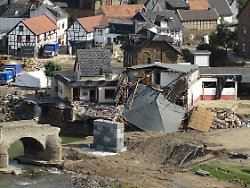Saturday, September 25, 2021
Insurer with a capital buffer
A billion euros were paid out to victims of the flood
Around a fifth of the sum for the insured damage caused by the flood disaster in July in Rhineland-Palatinate and North Rhine-Westphalia has now been paid out, as the industry association reports. Concerns about the financial stability of insurers are unfounded.
Around ten weeks after the flood disaster in western and southern Germany, insurance companies have already settled over a fifth of all insured damage. “We have already paid out more than a fifth of the loss amount, around 1.5 billion euros,” said Jörg Asmussen, General Manager of the German Insurance Association (GDV), the editorial network in Germany. “Around one billion euros went to private households and around half a billion euros to businesspeople, including many small and medium-sized companies.”
The total amount of the insured damage is around 7 billion euros, continues Asmussen. There are 250,000 individual cases of damage, of which 50,000 were destroyed cars. “The rain depression Bernd and the flood that followed were the worst natural disaster that we have seen in Germany since the Second World War,” said Asmussen. A total of 16,000 employees of the insurers and insurance brokers were on duty in the flood areas, as well as 2,500 external workers, for example experts.
Insurers have sufficient capital buffers
Asmussen emphasized that there was no need to worry about the financial stability of the insurer, despite the size of the damaging event. “Insurance companies can deal with damaging events such as floods. They are part of our business. Firstly, our companies are reinsured. And secondly, the insurance industry has a sufficiently large capital buffer.”
He was skeptical about a possible compulsory insurance: “It would be a mistake to introduce mandatory insurance that would then have to bear the costs of not adapting to the impact of the climate,” he said. “From our point of view, it would be much more important to have an overall concept that also includes state and private prevention.”
